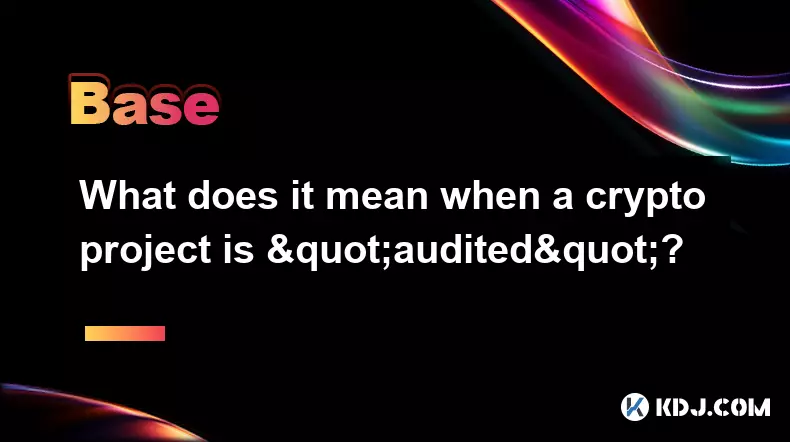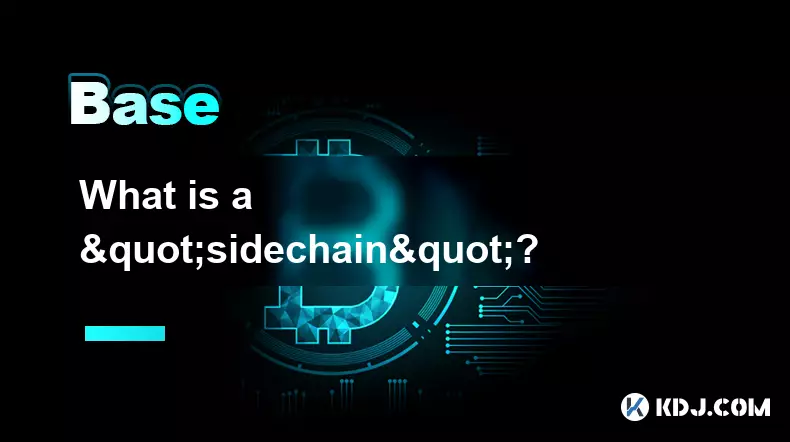-
 bitcoin
bitcoin $114684.631706 USD
-0.87% -
 ethereum
ethereum $4228.677447 USD
1.58% -
 bnb
bnb $1294.880693 USD
-1.16% -
 tether
tether $1.000819 USD
-0.02% -
 xrp
xrp $2.605138 USD
2.79% -
 solana
solana $209.908690 USD
5.89% -
 usd-coin
usd-coin $0.999903 USD
-0.03% -
 dogecoin
dogecoin $0.213423 USD
2.93% -
 tron
tron $0.322721 USD
-0.10% -
 cardano
cardano $0.727247 USD
3.66% -
 hyperliquid
hyperliquid $42.339456 USD
6.05% -
 chainlink
chainlink $19.910811 USD
5.16% -
 ethena-usde
ethena-usde $1.000557 USD
0.00% -
 stellar
stellar $0.349734 USD
2.69% -
 bitcoin-cash
bitcoin-cash $543.848687 USD
-0.21%
What does it mean when a crypto project is "audited"?
A crypto audit means an independent firm reviewed the code for vulnerabilities, but it doesn’t guarantee safety—just reduces risk.
Oct 12, 2025 at 01:18 am

What Does It Mean When a Crypto Project Is 'Audited'?
When a crypto project is described as 'audited,' it refers to a comprehensive technical review of its smart contracts and underlying code by an independent third-party security firm. The purpose of this audit is to identify vulnerabilities, logical errors, or potential exploits that could compromise the safety of user funds or the integrity of the system. Audits are not one-time events but part of an ongoing process to maintain trust and functionality in decentralized environments.
Why Are Crypto Audits Important?
- Audits help detect critical flaws such as reentrancy attacks, integer overflows, or improper access controls before deployment on a blockchain network.
- Projects with verified audits are more likely to gain credibility among investors, developers, and exchanges considering integration.
- An audit report provides transparency, allowing users to assess the level of risk associated with interacting with a protocol.
- Even after launch, periodic audits ensure that updates or new features don’t introduce new attack vectors.
- The presence of a reputable audit can deter malicious actors who may otherwise target unaudited or poorly secured protocols.
Who Conducts These Audits?
- Firms like CertiK, OpenZeppelin, PeckShield, and Trail of Bits specialize in blockchain security and perform rigorous testing on smart contract systems.
- Auditors use both automated tools—such as static analysis scanners—and manual code reviews to examine every function and interaction path.
- Some teams also run bug bounty programs alongside formal audits, incentivizing white-hat hackers to report vulnerabilities for rewards.
- The auditors produce detailed reports outlining findings, categorized by severity (e.g., high, medium, low, informational).
- Reputable firms often publish their methodology and maintain public track records, making it easier to verify their expertise.
Limitations of Crypto Audits
- An audit does not guarantee that a project is 100% secure; it only confirms that known issues were addressed at the time of review.
- New attack methods emerge constantly, meaning a previously safe contract might become vulnerable later.
- Some audits are rushed or conducted superficially, especially if the auditing firm lacks experience or independence.
- A project may pass an audit but still have design-level risks not caught by code inspection alone.
- There have been cases where audited projects suffered breaches due to logic flaws outside the scope of the original assessment.
Frequently Asked Questions
Q: Can a project be considered safe just because it has been audited?A: No. An audit reduces risk but doesn't eliminate it. Users should still research the team, community feedback, and whether fixes from audit recommendations were actually implemented.
Q: Do all blockchains require the same type of audit?A: While the core principles remain similar, audits vary depending on the blockchain's architecture. For example, Ethereum-based ERC-20 tokens involve different checks than Solana programs or Bitcoin layer-2 solutions.
Q: How long does a typical crypto audit take?A: It depends on complexity. Simple token contracts may take a few days, while full DeFi protocols with multiple components can require several weeks of analysis.
Q: Are audit reports publicly available?A: Most legitimate projects publish their audit reports on official websites or through the auditor’s platform. Lack of public documentation should raise red flags for potential users.
Disclaimer:info@kdj.com
The information provided is not trading advice. kdj.com does not assume any responsibility for any investments made based on the information provided in this article. Cryptocurrencies are highly volatile and it is highly recommended that you invest with caution after thorough research!
If you believe that the content used on this website infringes your copyright, please contact us immediately (info@kdj.com) and we will delete it promptly.
- XRP Price Prediction: Weekend Rollercoaster or Rally?
- 2025-10-12 08:45:16
- Bittensor (TAO): Super Bullish Signals Point to Potential 2x Rally
- 2025-10-11 10:25:12
- Silver Price Correction: Navigating the Dip & Identifying Key SEO Keywords
- 2025-10-11 10:25:12
- Decoding Crypto Trends: Bittensor's Bull Run, Cardano's Dip, and LivLive's Presale Buzz in 'Uptober 2025'
- 2025-10-12 08:45:16
- MoonBull: The Crypto Meme Coin Promising 1000x Gains?
- 2025-10-11 10:30:01
- Crypto Payroll Revolution: Stablecoins, Altcoins, and the Future of Salary Payments
- 2025-10-11 10:30:01
Related knowledge

What does it mean for code to be "open source" in crypto?
Oct 12,2025 at 01:54pm
Understanding Open Source in the Cryptocurrency Ecosystem1. In the context of cryptocurrency, open source refers to software whose code is publicly ac...

What is the purpose of a "testnet"?
Oct 12,2025 at 09:01am
Understanding the Role of Testnets in Blockchain Development1. A testnet serves as a parallel version of a blockchain network, designed specifically f...

How to avoid phishing scams in crypto?
Oct 13,2025 at 06:18pm
Understanding Common Crypto Phishing Tactics1. Cybercriminals frequently use fake websites that mirror legitimate crypto exchanges or wallet platforms...

What is the difference between single-collateral and multi-collateral Dai?
Oct 12,2025 at 05:18pm
Understanding Single-Collateral Dai1. Single-Collateral Dai (SCD) was the original version of the Dai stablecoin launched by MakerDAO in 2017. It allo...

What is a "sidechain"?
Oct 13,2025 at 02:36pm
Understanding the Concept of Sidechains1. A sidechain is a blockchain that operates independently but is connected to another blockchain, known as the...

What is "EIP-1559" and how did it change Ethereum?
Oct 12,2025 at 03:00am
Understanding EIP-1559 and Its Core Mechanism1. EIP-1559 is a protocol upgrade introduced to the Ethereum blockchain as part of the London hard fork i...

What does it mean for code to be "open source" in crypto?
Oct 12,2025 at 01:54pm
Understanding Open Source in the Cryptocurrency Ecosystem1. In the context of cryptocurrency, open source refers to software whose code is publicly ac...

What is the purpose of a "testnet"?
Oct 12,2025 at 09:01am
Understanding the Role of Testnets in Blockchain Development1. A testnet serves as a parallel version of a blockchain network, designed specifically f...

How to avoid phishing scams in crypto?
Oct 13,2025 at 06:18pm
Understanding Common Crypto Phishing Tactics1. Cybercriminals frequently use fake websites that mirror legitimate crypto exchanges or wallet platforms...

What is the difference between single-collateral and multi-collateral Dai?
Oct 12,2025 at 05:18pm
Understanding Single-Collateral Dai1. Single-Collateral Dai (SCD) was the original version of the Dai stablecoin launched by MakerDAO in 2017. It allo...

What is a "sidechain"?
Oct 13,2025 at 02:36pm
Understanding the Concept of Sidechains1. A sidechain is a blockchain that operates independently but is connected to another blockchain, known as the...

What is "EIP-1559" and how did it change Ethereum?
Oct 12,2025 at 03:00am
Understanding EIP-1559 and Its Core Mechanism1. EIP-1559 is a protocol upgrade introduced to the Ethereum blockchain as part of the London hard fork i...
See all articles










































































